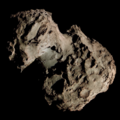C/2019 Y1 (ATLAS)
Appearance
Semi-major axis ~240 AU | | |
| Eccentricity | 0.99651 | |
|---|---|---|
| Orbital period | ~3,720 years | |
| Inclination | 73.348° | |
| 31.366° | ||
| Argument of periapsis | 57.498° | |
| Mean anomaly | 0.007° | |
| Last perihelion | 15 March 2020 | |
| Earth MOID | 0.083 AU | |
| Jupiter MOID | 1.026 AU | |
| Physical characteristics[4] | ||
| Dimensions | 1.2 km (0.75 mi) | |
| Comet total magnitude (M1) | 11.9±1.0 | |
| Comet nuclear magnitude (M2) | 13.8±0.5 | |
C/2019 Y1 (ATLAS) is a
C/2015 F3 (SWAN) and C/2023 V5 (Leonard), suggesting they may be fragments of a larger ancient comet.[5]
Observations

The comet passed close to Earth in early May 2020. It was visible in the northern hemisphere sky in the spring of 2020.
References
- ^ "MPEC 2020-A72 : Comet C/2019 Y1 (ATLAS)". www.minorplanetcenter.net. Minor Planet Center. 5 January 2020. Retrieved 25 January 2025.
- ^ D. W. Green (5 January 2020). "Comet C/2019 Y1 (ATLAS)". Central Bureau for Astronomical Telegrams. 4708.
- ^ a b "C/2019 Y1 (ATLAS) – JPL Small-Body Database Lookup". ssd.jpl.nasa.gov. Jet Propulsion Laboratory. Retrieved 13 May 2020.
- .
- ^ D. Dickinson (25 March 2020). "Following Comet Y1 ATLAS: the "Lost Comet" of Spring". Universe Today. Retrieved 14 May 2020.
External links
Wikimedia Commons has media related to C/2019 Y1.
- C/2019 Y1 at the JPL Small-Body Database
- TheSkyLive Archived 7 June 2020 at the Wayback Machine Comet C/2019 Y1 (ATLAS)
- astro.vanbuitenen.nl 2019Y1


